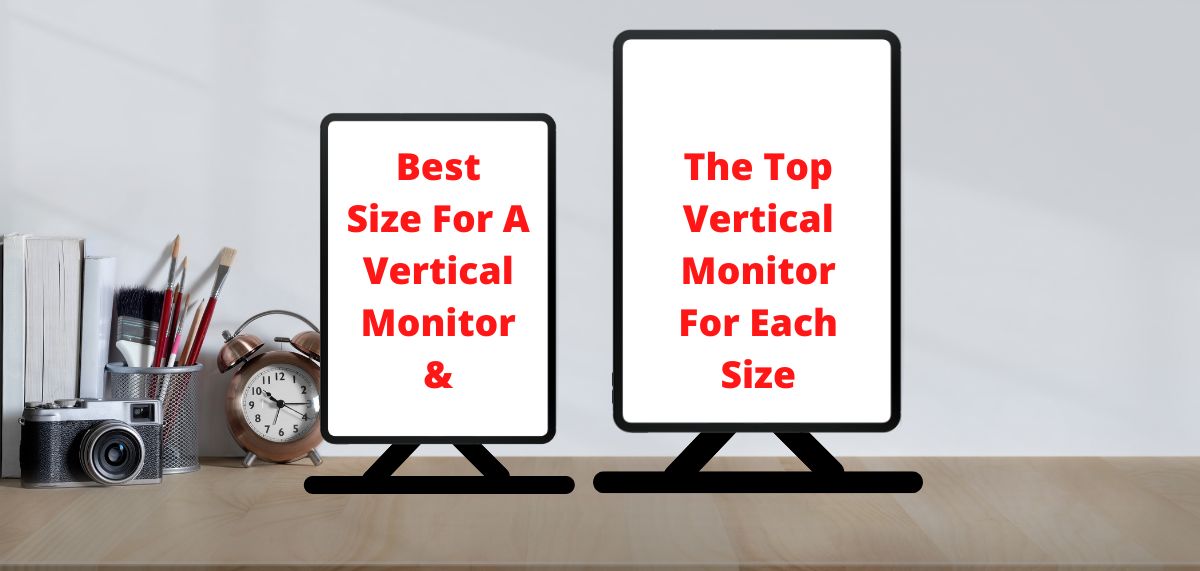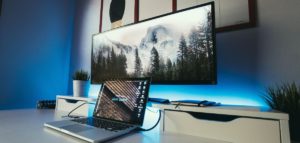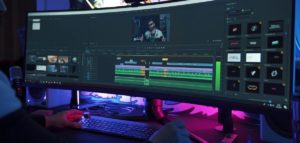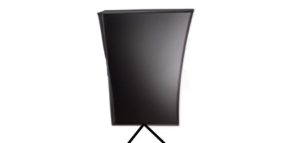Any 21 to 32 inch monitor that is either VESA mountable, or has a 90 degree pivoting stand is suitable for use in portrait mode. A 24 inch vertical monitor has the ideal screen size for most use cases. Certain tasks such as coding and editing are often better suited by larger 27 inch monitors.
When it comes to the aspect ratio of a vertical monitor, I recommend sticking to a standard 16:9 ratio. A 21:9 ultrawide monitor is excessive unless you have a specific use case in mind. 16:10 monitors are suitable, however, they are usually more expensive than 16:9 screens and have few advantages.
When it comes to choosing the best size specifically for you, there are a few things you’ll need to consider. I’ll explain all of that in more detail later. Plus I’ll give you some suggestions of the best size for some common tasks, and a suitable vertical monitor for each size I recommend.
We may receive a commission when you use our links. This is at no extra cost to you and never affects our suggestions.
How To Determine The Best Size Vertical Monitor For You
Here are a few of the key considerations to make when choosing the right portrait monitor size for your setup.
Space Available
The first thing you need to do is measure the amount of desk space you have available. You need to account for the monitor’s stand or any other hardware it might be mounted on. Once you have that measurement, you can start narrowing down your choices.
For example, if you only have 13 inches (33 cm) of depth to work with then a 21.5-inch (54.6 cm) monitor isn’t going to be an option. In general, the larger the monitor, the deeper it will be. So, keep that in mind when making your decision.
Other Monitors
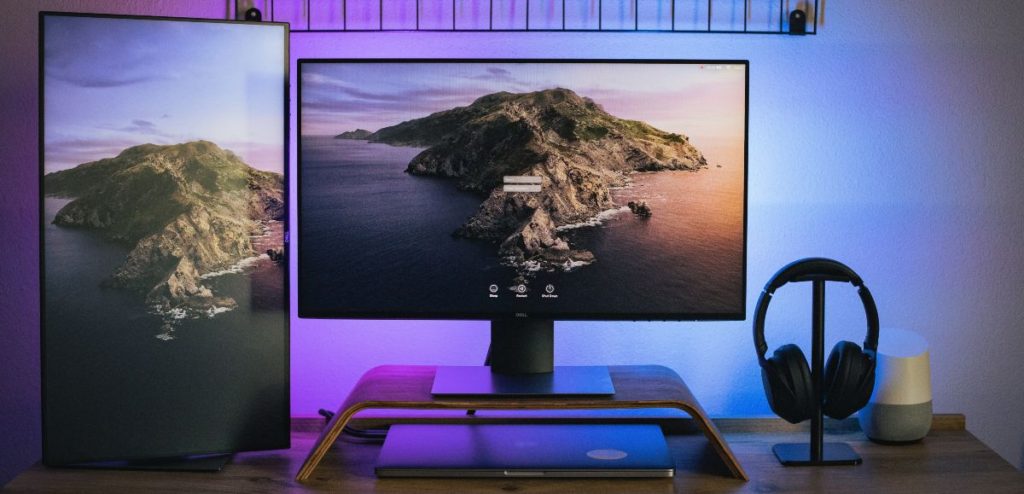
Of course, this heading is irrelevant if you only want a vertical monitor but vertical monitors are usually found as part of a multiple monitor setup. It’s up to you whether this is something that you want to take into consideration, but having certain matching specifications between your monitors is ideal if possible. Here are a few things to consider if you have multiple monitors:
- The stands and frames of your monitors should be similar in color and thickness.
- Your monitors should have a similar pixel density & refresh rate
The first point about the stand and frames is mainly for aesthetics, so not too important. However, in a multiple monitor setup, monitors having thick borders and frames can add friction when switching between screens.
The second point won’t make or break your setup either. To be completely transparent I don’t exactly follow this advice myself (I have one 60Hz and one 144Hz monitor). That said, it is advisable to have a similar PPI and refresh rate between your monitors. This makes it easier for your eyes to adjust and switch between monitors but perhaps, more importantly, makes it smoother for your operating system to run multiple monitors.
Your Use For The Monitor
The next thing you need to consider is what you’re going to be using the monitor for. If you only plan on using it in a vertical orientation then you don’t need as large of a monitor as someone who plans on flipping it back and forth between horizontal and vertical.
For example, if all you’re going to use the monitor for is web browsing and reading documents then a 24-inch monitor will be plenty. However, if you also intend to do some light gaming or video editing then you might want something a bit larger like a 27-inch monitor.
Here are the ideal vertical monitor sizes for different tasks. You can learn why I recommend these sizes after the top monitors for each size.
| Main Use For Monitor | Recommended Screen Size |
|---|---|
| Coding | 27 inches |
| Reading | 21-24 inches |
| Streaming | 24 inches |
| Editing | 27-32 inches |
| Other / General Use | 21-27 inches |
Best Vertical Monitor For Each Screen Size
All the monitors below can be used in portrait to achieve a vertical monitor setup.
Some come out of the box with a stand that allows the screen to pivot to a vertical position. Others will require a VESA monitor arm, wall-mount, or stand to allow them to be used vertically.
Each pick will tell you whether a separate mount is required to get a portrait monitor.
Here’s a monitor arm I recommend for creating your vertical monitor setup, if you require one.
So let’s get into the picks for the best portrait monitors at each screen size.
SAMSUNG Odyssey G3 – Best 24″ Vertical Monitor
If you are looking for a vertical monitor that you can flip to a vertical monitor without a new stand, something like the Odyssey G3 is what you are looking for. Due to the ease with which you can switch between a portrait and horizontal setup this monitor is perfect if you would like to play games or watch videos on this monitor as well.
The response time of 1ms is suitable for casual and hardcore gamers alike. The 144Hz rate backs that up, providing a smoother experience while you are gaming or simply scrolling on social media.
This monitor is FHD meaning that while it is great for reading, gaming, and scrolling the internet, you may want a higher resolution if you are editing or watching movies.
If you want a monitor that can switch between orientations with ease and can be used for more than just everyday tasks then you can find the Odyssey G3 on Amazon.
Pros
- 144Hz
- Stand pivots for easy vertical setup
- 1ms response time
- AMD FreeSync
Cons
- Only FHD. QHD or 4k is desirable for tasks like editing
ViewSonic VX3276-2K-MHD – Vertical Monitor With The Best Specifications
If you are an editor, this is the monitor for you on this list of vertical monitors. Of course, the main selling point of this monitor is the UHD 4k display that provides a beautiful image perfect for graphic design, entertainment, or office work.
Meanwhile, the 80M:1 MEGA Dynamic Contrast Ratio delivers incredibly crisp images. And the incredible performance is matched by the sleek design, with ultra-slim bezels.
While performance is prioritized in this monitor, comfort certainly isn’t sacrificed. Utilizing flicker-free, blue light filter technologies, and an anti-glare coating it’s built for all-day comfort. This is a good thing because you certainly won’t want to leave your desk with this beast at your disposal.
There’s a wide range of models with different sizes and resolutions. I recommend the 27″ and 32″ models, you can view the 27″ model here on Amazon. And find the 32″ model here.
Pros
- 4k UHD – perfect for demanding tasks like editing or watching 4k movies
- Comfort, performance, and great design – all without compromise
- Easily VESA mountable
Cons
- Requires a VESA mount or monitor arm for vertical usage
Sceptre E248W-19203R Series – Best Budget Vertical Monitor
Sceptre is a budget monitor manufacturer and this particular model is one of the best deals you can find for a 24″ monitor.
As you would expect this monitor is FHD and has a 75Hz refresh rate. This makes it a great option for general tasks, as well as console gaming. The 3ms response time is somewhat more impressive and leans towards potential gaming use.
You won’t be able to use this monitor in portrait mode out of the box. However, it does have VESA-compatible mount holes so mounting for use vertically shouldn’t be too difficult.
Considering the price-point this slim metallic design is impressive. The specifications are perfect for anyone on a budget looking for a vertical monitor. If that’s you then find this display here on Amazon.
Pros
- Great on a budget
- VESA mount ready
- Sleek design
- 2x HDMI ports
Cons
- Requires a VESA mount / monitor arm
ASUS VA27DQSB – Best Vertical 27″ Monitor
This is another great option if you are looking for a monitor that can pivot into a vertical setup out of the box. The VA27DQSB is the golden standard when it comes to ergonomic adjustability.
At 27″+ it can be substantially more difficult to find monitors with stands that allow for a portrait mode setup. This display not only offers that but also substantial connectivity including DisplayPort, HDMI, and USB hub.
The ASUS eye care technology within this screen includes flicker-free and low blue light capabilities. Both ensure a comfortable viewing experience designed to minimize eye fatigue.
If you are interested in the VA27DQSB, you can view it on Amazon here.
Pros
- Out-of-the-box vertical monitor setup
- 75Hz refresh rate, FHD
- Eye care technologies
- DisplayPort cable, HDMI cable, and USB cable included in the box
Cons
- Not suitable for tasks requiring high resolution
HP V223ve FHD – Best 21″ Monitor For Portrait Mode
Perfect for reading, browsing the internet, or writing, this budget monitor from HP is a perfect option for a smaller-sized vertical monitor setup. The low blue light mode also makes the monitor perfect for these tasks, allowing you to use the monitor later into the night without having to worry about sacrificing sleep.
This monitor is aimed at everyday use so offers a 75Hz refresh rate and Full HD resolution. These specifications are nothing crazy but exactly what you should be looking for if you want a cheap vertical monitor for checking emails or supplementing a horizontal monitor you already own.
The screen doesn’t pivot into portrait mode using the stand it comes with, however, it does support VESA mounting so you can easily and cheaply convert this monitor into a vertical monitor. If you want a monitor that comes with a stand that allows the monitor to pivot 90 degrees then the next monitor on the list may be more to your liking.
If you are interested in the V223ve it’s available to view on Amazon.
Pros
- Great Value
- Ideal for everyday tasks
- Low blue light mode
Cons
- Insufficient specs for intense tasks such as video editing or gaming
- Requires VESA mount
Samsung C27F390FHN – Best Curved Monitor For Portrait Orientation
You might think a curved monitor seems pointless for a vertical monitor setup. I can’t lie, it’s not to my taste. However, it is possible to use a curved monitor in a portrait orientation, and some people like the immersive feel.
Even if you are not buying a curved monitor for the sole purpose of vertical use, but rather for horizontal use primarily, then having a curved monitor capable of going vertical can have its uses.
The 60Hz refresh rate and FHD specifications might seem underwhelming, however, this is a monitor primarily designed for use in a business setting. And in that setting, this monitor really does shine.
The blue light filtering and flicker-free screen is suitable for long usage, again ideal in a business setting. While the VESA monitor arm compatibility makes turning this display into a vertical monitor easy.
If you are interested in the C27F390FHN you can see it here on Amazon.
Pros
- Curved design
- Surprisingly good value
- Easily mountable
Cons
- Only a 60Hz refresh rate
SAMSUNG 34-Inch SJ55W – Best Ultrawide Monitor For Using Vertically
Yes. You can use an ultrawide monitor vertically. When it comes to why you might want to, I can’t give you as straightforward of an answer.
It would be impossible to have a stand that can rotate an ultrawide monitor vertically, however, this monitor is VESA mount compatible so can be flipped for vertical use.
The WQHD and 3000:1 contrast ratio mean the display not only puts forward impressive features but also has an elegant and slim design. You can view it here on Amazon.
Pros
- WQHD resolution
- AMD FreeSync
- VESA mountable
Cons
- There are limited uses for a vertical ultrawide monitor
Best Size Vertical Display For Some Common Tasks
Coding
27″ is a suitable size for coding as you often need to have multiple windows open on your one vertical monitor. A larger monitor will also make it easier to find errors in your code, by allowing you to see more code at once, will also help to reduce eye strain. There are also plenty more benefits to using a portrait monitor in your programming setup.
Reading
21-24″ is a great size range if your primary intention is reading documents, articles, or books on your portrait monitor. This is because you don’t need too much screen real estate to do this comfortably. Anything larger than 27″ can make reading more difficult as your eyes have to keep track of where they are in a longer line of text.
Streaming
24″ is a great size for streaming as it provides a balance between being large enough to see chat clearly, without being distracting or taking up your whole desk.
A 24″ monitor is perfect for reading your chat, a vertical monitor setup can also help your streaming setup in many other ways.
Editing
27-32″ is the ideal range for a vertical monitor for editing. Whether this is photo or video editing, this size range is perfect for any editor working on a portrait project. With the rise of YouTube Shorts and TikTok, video editing vertical projects with a 9:16 aspect ratio has become far more common.
A vertical monitor better allows you to tackle editing any portrait image or video, simply because you can see more of each image at once. Not having to zoom in as much can be a great benefit for any editor. A 27-32 inch monitor best allows you to view your project on a vertical display.
General Use
21-27″ is quite a big range, but that’s because things like web browsing can be so broad. A web browser can be used for a variety of tasks from checking emails to streaming videos and anything in between. As a result, the best size for vertical web browsing really depends on what you’ll be doing most often on your device.
I can’t tell you the perfect size for you if you have a large number of uses. Looking above at the recommended size for different specific tasks should help you in your decision.
Conclusion
The important thing to remember is that the best size for a vertical monitor is the one that suits your needs the best. There is no perfect size that everyone should use, it all comes down to personal preference and what you’ll be using the monitor for.
If you’re still not sure which size is best for you then we recommend trying out a few different sizes before making your final decision. Many stores will let you return a monitor if it’s not the right fit, so you can always buy a few different ones and see which one you like best. If you don’t feel like doing that 24″ is probably the safest bet for most situations.

